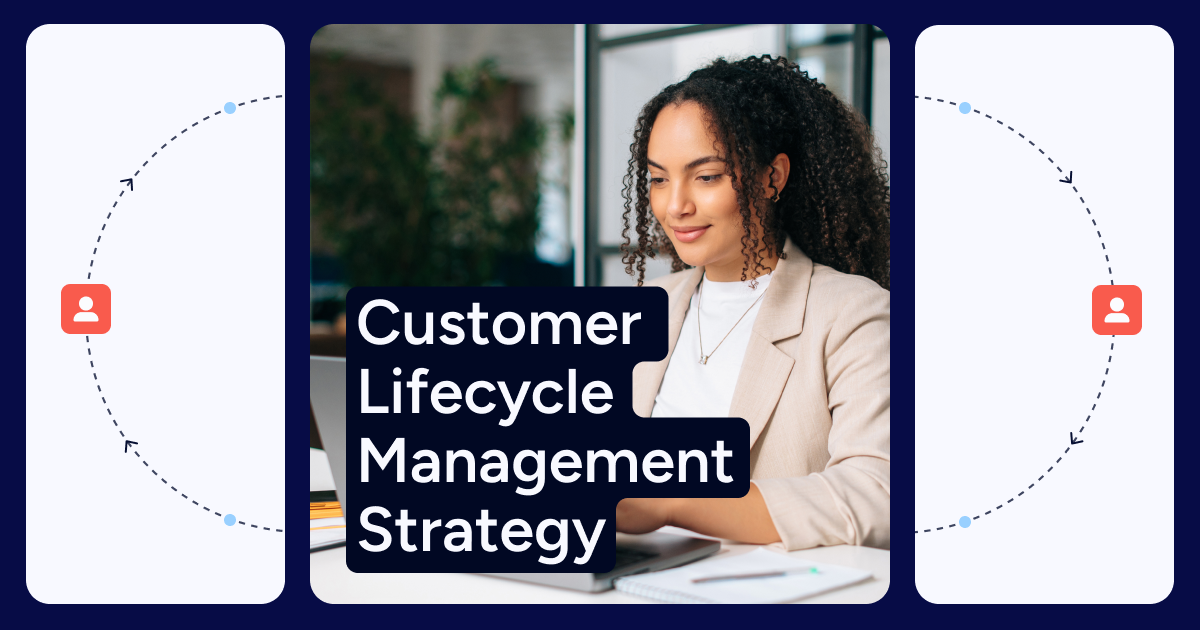If you’re still thinking about customer journeys as a linear sequence of stages in a purchasing funnel, you’re already behind.
Customer lifecycle management (CLM) gives B2B teams a measurable way to control and optimize the full customer experience, from initial awareness through renewal, expansion, and advocacy.
In this article, we’ll break down the five stages of the customer lifecycle, the five pillars of a winning CLM strategy, and how B2B teams can use data, automation, and predictive insights to drive growth at every stage.
What Does Customer Lifecycle Management Really Mean?
Customer lifecycle management is the process of segmenting, tracking and optimizing every step of the customer journey from initial engagement to purchase, renewal, and long-term loyalty.
Unlike the traditional customer journey, CLM is a cross-functional discipline. It brings together marketing, sales, customer success, customer experience and product teams to satisfy the needs of your company’s key buyer personas.
Why CLM Matters More Than Ever
Every prospect leaves behind thousands of data points: where they spend time online, what content they interact with, their buying signals, pain points and more. If your business isn't using CLM to leverage that data, you're giving your competitors an easy win.
CLM gives B2B companies a competitive edge by solving real business challenges, including:
Rising customer acquisition costs
The need to increase customer lifetime value (CLV)
Pressure to drive more growth through customer retention
Managing complex buyer’s journeys
Avoiding growth-limiting data silos
Responding to buyer intent in real time
The Stages of the Customer Lifecycle
There are many ways to frame customer lifecycles. We’ve found that CLM is most effective when it’s mapped across five stages of the customer lifecycle.
1. Customer Awareness or Reach
What it is: This is where the customer journey begins. A prospect is introduced to your company, product, or service.
Customer goal: Learn something new or solve a general problem.
Business goal: Capture attention, improve visibility and increase brand recognition. No expectation of purchase yet.
2. Consideration
What it is: The prospect has identified a need and is researching options. They’re comparing solutions and evaluating providers.
Customer goal: Find the right product or service to solve their problem.
Business goal: Build trust, demonstrate value and position your offering as a top choice.
3. Conversion or Purchase
What it is: The prospect becomes a customer. This could mean making a purchase, signing up for a demo or submitting a form.
Customer goal: Commit to a solution that fits their needs.
Business goal: Facilitate a seamless buying experience and remove friction from the path to conversion. (Note: some teams treat form completions as part of this stage, while others separate them into late-consideration.)
4. Customer Retention Stage
What it is: Here, the focus shifts to serving existing customers. You want to provide ongoing value, support and engagement after the initial purchase.
Customer goal: Get continued value from the product and receive support when needed.
Business goal: Increase satisfaction, reduce churn and turn one-time buyers into long-term users or repeat purchasers.
5. Customer Loyalty or Advocacy
What it is: Satisfied customers become brand advocates. They actively support your brand through reviews, referrals or user-generated content.
Customer goal: Feel confident in their choice and rewarded for their loyalty.
Business goal: Enable and empower your happiest customers to influence others and fuel organic growth. Loyalty programs, referral incentives and customer success touchpoints all play a role.
The 5 Pillars of a Winning Customer Lifecycle Management Strategy
While every B2B team’s customer lifecycle management strategy will be different based on company goals and culture, there are five pillars that should be included, regardless of industry.
Pillar 1: Data-Driven Segmentation and Targeting
CLM starts with knowing exactly who you’re targeting and why. Modern segmentation goes far beyond static firmographic lists, allowing GTM professionals to segment and target prospects with precision. It blends:
Demographic and firmographic data
Intent signals showing real-time buyer interest
AI-fueled insights and recommendations
How ZoomInfo can help: We provide continuously updated firmographic, technographic, intent and behavioral data through tools like contact & company search, data enrichment and ICP modeling. Advanced filters, dynamic lists and segmentation tools turn basic lists into intelligent cohorts.
Pillar 2: Orchestrated, Omnichannel Journeys
Today’s buyers interact across email, social, chat, events and content, often in a nonlinear pattern. A strong CLM strategy connects all these touchpoints into one cohesive experience, from awareness to renewal.
This requires alignment across marketing, sales and customer success. It also requires unified messaging, consistent data and real-time collaboration on where a buyer is in the journey.
How ZoomInfo can help: With ZoomInfo Marketing, you can orchestrate campaigns across email, social and ads. Tools like website chat and ZoomInfo FormComplete capture and route inbound interest in real time, while cloud partner integrations keep customer data standardized and synced across platforms.
Pillar 3: Predictive Lifecycle Intelligence
Most of today’s B2B buyer journey happens anonymously. Predictive intelligence helps you detect interest before a prospect ever fills out a form, allowing your team to proactively engage, prioritize accounts and close deals faster.
Signals like search behavior, topic spikes, content engagement and historical buying patterns help you predict both churn and opportunity.
How ZoomInfo can help: Our intent data and AI-fueled ZoomInfo Copilot surface hidden account activity and prioritize in-market prospects with predictive scoring. This helps sales and marketing act before competitors even know a prospect is evaluating solutions.
Pillar 4: Proactive Customer Success
Modern customer success goes beyond ticket resolution. It’s about anticipating needs, delivering value proactively and improving the post-sale journey.
This includes onboarding, training, adoption support and proactive check-ins based on account health. Done right, this turns customers into advocates and drives expansion, not just retention.
How ZoomInfo can help: With Chorus, customer success teams can capture and analyze conversations for adoption insights and churn signals. Paired with ZoomInfo Operations for clean, standardized account data, you can track engagement trends, map new decision-makers and receive alerts when it’s time to re-engage.
Pillar 5: Continuous Optimization and Revenue Feedback Loops
CLM is never static. Teams need to continuously review what’s working, what isn’t and how customer data can inform improvements across the funnel.
This includes analyzing key metrics like:
Net Revenue Retention (NRR)
CAC Payback and Expansion MRR
Activities that influence churn or advocacy
Data from retention and expansion should inform lead quality, onboarding, sales engagement and product.
How ZoomInfo can help: With Operations and Data as a Service, you can centralize data and connect pipeline activity to revenue outcomes. Workflow tools automate data sync and reporting, creating a continuous feedback loop that improves segmentation, outreach and customer engagement over time.
Implementing CLM Across the Team
Implementing a CLM strategy and executing it across an organization takes total buy-in from all relevant teams. Here’s a closer look.
Team | Key Actions | Business Impact |
Marketing | Build lifecycle-driven content and nurture flows Leverage intent and demographic/behavioral/firmographic data Coordinate cross-channel messaging and campaigns | Better brand awareness Higher engagement Higher-quality leads and overall pipeline quality |
Sales | Use customer health scores and intent triggers to prioritize sales resources | Drive revenue by meeting customer expansion needs |
Customer Success | Intervene early in churn signals Create onboarding and product use playbooks Encourage and drive advocacy | Improved retention, referrals and advocacy |
RevOps | Integrate teams, tools and data Track KPIs Build dashboards for easy visibility | Improved and faster decision-making Scalable growth |
CLM KPIs That Measure Growth
Because CLM is still a relatively new way of thinking, it’s important to track the right KPIs to measure its effectiveness. Essential KPIs and metrics include:
Customer Health Score: This tracks how your customers measure up against a particular outcome you’ve defined as valuable and can be used for both new and returning customers.
Net Revenue Retention (NRR): A financial measure of your churn or growth, with goals sometimes above 100% to reflect larger spend with existing customers. NRR reflects the value your product or service delivers, especially when it comes to things like pricing and support.
Time-To-Value (TTV): TTV measures how long it takes for a new customer to experience the benefits of your core product or service.
CAC vs. CLV: Customer Acquisition Cost vs. Customer Lifetime Value reveals how profitable (or not) your go-to-market tactics are. If CAC is below CLV, then the incremental cost of acquiring a new customer is sustainable, even if the upfront investment may seem large.
Product Adoption Rate: How many new customers start actively using your product’s core features within a set timeframe. It helps identify delays in onboarding and shows how quickly users begin to see real value.
Free-to-Paid Conversion Rate: Measures how long it takes for customers to transition from a free trial to a paid conversion.
Time to Value: This onboarding metric measures how long it takes for a closed sale to yield a customer who has been onboarded and is using the product for the first time.
How ZoomInfo Accelerates CLM Success
ZoomInfo gives B2B teams the data and tools needed to bring CLM strategies to life. From first touch to long-term loyalty, our GTM Intelligence Platform helps you:
Segment audiences with up-to-date contact, firmographic and intent data
Identify and prioritize in-market buyers early
Align marketing, sales and customer success with shared insights
Identify churn risk and uncover expansion opportunities
Personalize engagement across channels in real time
With a unified platform and rich data foundation, we can help you turn insights into impact and prospects into lifelong customers.
Level Up Your CLM Strategy Today
Don’t just settle for the same old marketing campaigns or CRM-driven touch points. Incredible amounts of data are flowing, and you can optimize and leverage all of it with ZoomInfo.
We can help you close sales faster and with greater customer satisfaction. Contact our sales team to level up your CLM strategy today.


